Talking Heads
There's
a party in my mind.
Albums
Reviewed: Talking Heads: '77, More Songs about Buildings and Food, Fear of Music, Remain
in Light, Speaking in
Tongues.
Talking
Heads were one of the strongest American New Wave bands, but frequently
I find them irksome. Blame frontman David Byrne for that, but
credit him for much of the band's character. Ultimately, the
band
was probably the strongest and longest lasting to emerge from New Wave
scene, but I still favor Television or Blondie.
Starting
with their second album, the band had a fruitful relationship with
Brian Eno, culminating with Remain
in Light.
Based on their first album, this is not surprising, given
that
the band exhibited the same goofy, oddball tone as early Roxy Music.
Conceptually,
the band focused on Byrne's quirky persona and the solid rhythm section
of Tina Weymouth on bass and Chris Frantz on drums. Escewing
solos like a lot of New Wave bands, some of the band's high points
relied on solid backing (including utility man Jerry Harrison) for
Byrne's personality and Brian Eno's noises and treatments.
Musically, they were the original spaced-out nerd/funk band,
and
mixed other styles in gradually.
I have do not have any of their albums beyond Speaking in Tongues,
although that is subject to change.
Talking
Heads: '77 (Sep.
1977),
***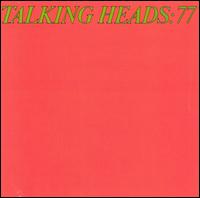
Just like
modern furniture, Talking Heads stripped down the sound of rock
music. The group had a wider
palette than others, thanks to Harrison's usfulness, but '77's tone is
locked down and simple, without
distortion or elaboration. While the
Sex
Pistols revolted against the order of society and promoted
anti-virtues, Talking Heads dealt in a
different
way. They had not reached rebellion, and instead internalized
it, making it frustration and control. The control is
pervasive
in the rhythm section's funk feeling.
It is felt in the clear
guitar
tones of both Jerry Harrison and David Byrne, and the scripted guitar
lines (the opening of "New Feelings", "Who Is It?").
In fact, the band usually created a couple of odd rhythms
based on some sort of minimalist funk or blues, and then shifted
between them. If this was all the band did, they would not be
very interesting. Frustration makes this album, and that
frustration usually appears as David Byrne. The
quintessence of this is "Psycho Killer", the band's first
hit. Over the set, rigid rhythm section comes Byrne's lyrics
about a person whose frustration with society has led him to the
boiling point, and beyond. Where Rotten was the psychotic,
Byrne is the stylist. His tenor vocals are clean, clipped, precise
and while the frustration builds in the music ("Who Is It?",
or his singing the word "day" in "Happy Day").
His lyrics also demonstrate distaste for contemporary society and
others ("No Compassion" about people with problems,
"Tenative Decisions" about indecision), and frequently
writes in first person. Certainly everyone has a lighter side
and sometimes Byrne's lyrics are a bit
childlike (the delightful "Don't Worry About the Government"
sounds like it was written while lying on a hill looking at clouds,
or the catchy 60s dancer "Pulled Up"). The band also
does dorky love songs (a mixed bag), so for every "Uh
Oh Love Comes to Town" there's a fluffy "Happy Day".
The band's later interest in world music is presaged in a couple
places (steel drums on "Uh Oh Love Comes to Town" and the
delightful "First Week/Last Week"), but not really
explored. A promising debut. Produced by Ramones
producer
Tony Bongiovi, former session guitarist Lance Quinn and the group.
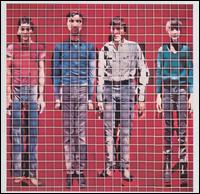 More
Songs about Buildings and Food (Jul. 1978), ***1/2
More
Songs about Buildings and Food (Jul. 1978), ***1/2
The
strategy of
white boy funk and polyrhythms, topped with
Byrne's unique vocal delivery, started to pay off on More
Songs. Idiosyncatic vocals and interest in
quirky pop music
aligned them splendidly with (Brian) Eno, who produced this album and
collaborated with the band for the next few
years. Byrne still exhibited a precocious child's
persona, and his
methodolgy seemed to
be to lock
himself into a midset and let loose. His
tastes were still arty: rejecting middle-class middle-America ("The Big
Country"), an obnoxious, menacing song about painting ("Artists Only"),
or satire of married life ("Found a Job"). When combined with
Eno's
periodic treatments and techniques, More Songs can been
seen as
an entirely new form of stylized art-rock, and the stylized honesty and
glossed, polite funk is also
a
counterpoint to Blondie's retro kitch. The band's focus on
rhythm intesified on this album - the tight
Frantz/Weymouth combo, the guitars playing scratchy
rhythm (the great "In Our Love", "Found a Job", "I'm Not in
Love"). Even the lighter, '77-esque material
is better (the growing complexity in "The Good Thing"), even
if "The Girls Want to be with the Girls" sounds like a reworking of '77's
"Tentative Decisions." But, oh, those rhythms (some African
ones
creeping in) and Eno's treatments snaking around with them.
Follow them, and you will be up there vocally mugging with
Byrne.
Ironically,
their first big hit is the track that fails to cater to their strengths
- a cover of Al Green's "Take Me to the River". When listened
to
next to the driving beats of the other tracks, Byrne becomes less
tolerable and its slow pace grinds. All is not
paradise, for
the
parts do not equal the whole. For while pieces of greatness
abound (the opening riff in "Warning Sign", "With Our Love", "Stay
Hungry"), Byrne is an acquired taste, both for his vocal style and his
simpleton lyrics. Better things were ahead for all, but More Songs began to
solidify their distinct style.
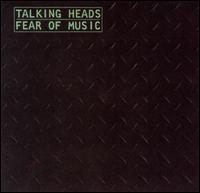 Fear
of Music (Aug. 1979), ****
Fear
of Music (Aug. 1979), ****
Still
going down the same road. Eno's production is suitably
layered
and inscrutible, and the band still maddening. Byrne
stopped
using his uncut thoughts as lyrics, resulting in less self-involved
rambling. Their polyrhythms, now slipping further towards
worldbeat,
keep
moving around and are tremendous their re-working of Hugo Ball's dada
poem "Gadji Beri Bimba" into one of their funk+beat masterpieces ("I
Zimba") is immencely clever, while the bubbling "Mind" and "Paper" both
kick the beat as well. Beyond that, every track has something
going for it. The more dance-tempo tracks have Byrne's
off-kilter
lyrics ("Cities" and "Animals"), although the lyrics are the weak part.
Some interesting hybrids blues-funk (the intrigue and paranoia of "Life
During Warfare" or more rock ("Memories Can't Wait" with the great line
"There's a party in my mind / and I hope it never stops").
Other
tracks rely too much on the production and animatronic rhythms to evade
lethargy ("Electric Guitar", slow-speed disorientation of "Drugs" or a
goofy ode about "Air"). Still, I found a little guitar line
from
"Electric Guitar" inhabiting my brain up to a week after
listening. Loopy, in every sense of the word.
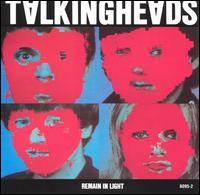 Remain in Light
(Oct. 1980),
****1/2
Remain in Light
(Oct. 1980),
****1/2
This
is Talking Heads' finest album, and a rather odd one at that, taking
their approach to music to a logical conclusion.
Remain in Light's
first side consists of three tracks which explore "I Zimba"
instrumental worldbeat, group vocal feel ("The Great Curve", "Crosseyed
and Painless" and "Born Under Punches"). Byrne and Enp's
master stroke was to treat
the instruments as a looping backing tape - scratchy
rhythms repeating, without real chords or progression.
Above
this, Byrne's twitchy spoken lyrics and sung choruses overlap and
intertwine. The scant solos are Kraftwerk with Tourette's
syndrome ("Crosseyed and Painless"). Both Byrne and the
backing
(the band and session people) are good enough to make this work,
despite the dangers.
The
second half is more traditional, but still removed from their earlier
work. With each successive album the Talking Heads moved
further
away from songs you could bash out on a guitar, and even Remain
in Light's
"normal" songs are too intricate. The album's key track is
"Once
in a Lifetime", a clever bit of social commentary packaged as
a
loopy pop song. The rest of the second side is similar.
The
songs are used as a
medium for storytelling like VU's "The Gift" ("Seen and Not
Seen")
or third-world mimcry ("Listening Wind"). While Byrne's voice
is
the focal point, the underlying music shows a greater interest in world
music - African beats, reggae, horn funk ("Houses in Motion") all sent
through the Eno
treatment factory and carefully deployed in the sound. The
album's weakest point comes at its end - "The Overload" a dark bit of
collapse, which drags. Is it even a band, or a carefully
arranged
canvas for Byrne's vocals and scraped guitar parts?
The line
gets blurred, but somewhere amidst all the beats, arrayed bass pops and
blurred guitar lines is the feeling that everything is a whole, led by
Byrne and Eno.
Jerry Harrison: The Red and the Black
(Oct. 1981)
Uh, Milwaukee
REPRESENT?
The Name of this Band is Talking
Heads (Apr. 1982)
A
well regarded live album. I have it. I am not going
to comment.
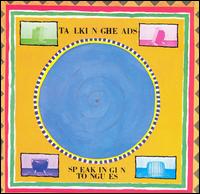 Speaking
in Tongues
(Jun. 1983), ****
Speaking
in Tongues
(Jun. 1983), ****
While
Remain
in Light
took the Talking Heads about as far as they could go in streaching
regular song structure, Speaking
in Tongues
is a smart retreat into dork funk/pop, with no Eno involvement.
All the pieces and sounds remain the same (such as transmuted
gospel in "Slippery People"), but Frantz and Weymouth create catchy
dance beats to underpin the songs, and some R&B/funk ringers
augment the
sound. The result is a brash pop album with a stong
synth-rock
components, but one in which you can hear the band members, not some
carefully planned studio collage. I feel like Speaking
in Tongues
would be a great
album for a dork wedding, with plenty of infectious, goofy fun
with Byrne's deadpan ("Burning
Down the House", "Making Flippy Floppy", "Girlfriend is Better" with
Bernie Worrell providing flashing light synth sounds, "Moon Rocks").
The exceptions are a mumbly blues tribute -- at least, I hope
it's a tribute -- on "Swamp", and "This Must Be the Place (Naive
Melody)" which returns to the airy pop of their earlier albums, just
with more synthesizers. No Adrian Belew this time around,
but
the players included Alex Weir from the Brothers
Johnson (guitar), Wally Badarou (synthesizer), and violinist Shankar.
Even though Remain
in Light is the better album, this one is a lot
more fun, and my favorite Heads album (so far). Self-produced.
Stop Making Sense
(Oct. 1984)
More liveness. I do not have any of their remaining albums.
Little Creatures
(Jun. 1985)
True Stories (Sept.
1986)
Naked (Mar. 1988)

 More
Songs about Buildings and Food
More
Songs about Buildings and Food Fear
of Music
Fear
of Music
 Speaking
in Tongues
Speaking
in Tongues